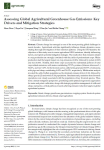Zhou S., Liu B., Wang J., Jin D., Zhang H. (2025). Assessing global agricultural greenhouse gas emissions: key drivers and mitigation strategies. Agronomy, 01/06/2025, vol. 15, n. 6, p. 1336.
http://doi.org/10.3390/agronomy15061336
http://doi.org/10.3390/agronomy15061336
| Titre : | Assessing global agricultural greenhouse gas emissions: key drivers and mitigation strategies (2025) |
| Auteurs : | S. Zhou ; B. Liu ; J. Wang ; D. Jin ; H. Zhang |
| Type de document : | Article |
| Dans : | Agronomy (vol. 15, n. 6, June 2025) |
| Article en page(s) : | p. 1336 |
| Langues : | Anglais |
| Langues du résumé : | Anglais |
| Catégories : |
Catégories principales 07 - ENVIRONNEMENT ; 7.5 - Dégradation : Impact, DésertificationThésaurus IAMM AGRICULTURE ; GAZ A EFFET DE SERRE ; REDUCTION DES EMISSIONS ; LUTTE ANTIPOLLUTION |
| Résumé : | Climate change has emerged as one of the most pressing global challenges in recent decades. Agricultural activities significantly influence climate dynamics, necessitating thorough investigation of their emission patterns. Using the FAO datasets, the objectives of this study were to assess agricultural GHG emissions, identify influencing factors, and explore potential mitigation strategies. The results show that emissions related to crop production are strongly correlated with the yields of predominant crops. Maize production had the largest impact on crop emissions (0.023), followed by potato (0.021) and rice (0.007). Notably, these three crops accounted for substantial portions of total crop-related emissions, with maize contributing 11.70%, potatoes (Solanum tuberosum L.) 10.21%, and rice 9.25%. In the livestock sector, cattle herds generated 10.75% of emissions, with pigs and sheep contributing 9.82% and 10.03%, respectively. Multivariate analysis revealed the cattle/buffalo population as the dominant emission driver (0.32), followed by sheep/goat (0.21) and swine (0.10) populations. Simultaneously, emissions from livestock operations were closely associated with the populations of key livestock species. Thus, from a climate mitigation perspective, prioritizing yield-optimized agronomic approaches for maize and potato cultivation, along with strategic population management of cattle and sheep, represents a critical pathway toward achieving emission reduction targets in global agricultural systems. |
| Cote : | En ligne |
| URL / DOI : | http://doi.org/10.3390/agronomy15061336 |







